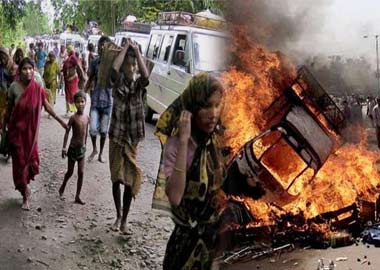
Kokrajhar, July 26: Clashes between Bodos and minority immigrants in four Assam districts continued for the seventh day today, leaving 44 people dead even as Chief Minister Tarun Gogoi insisted the situation was "improving" and rapped the media for portraying the state as "burning".
Prime Minister Manmohan Singh would visit Assam on Saturday to take stock of the situation and the steps being taken to control the unrest.
Indefinite curfew and shoot-at-sight orders were in force in worst-affected Kokrajhar district, while night curfew was on in Chirang and Dhubri districts.
Nearly two lakh people are taking shelter in 150 relief camps while 11 persons are missing.
Train services, which came to a complete halt for two days, have resumed with three special trains - one each to New Delhi, Kolkata and Bangalore - being run from Guwahati to take passengers who were stranded at different places along the route.
Gogoi, who arrived here this morning, said the toll had risen to 44 with three more deaths reported from Chirang district and one from Dhubri while 11 were still missing.
He said more than two lakh people were rendered homeless due to the violence.
IGP (Law and Order) L R Bishnoi said Kokrajhar district executive magistrate Bipul Saikia was injured in an attack by unidentified miscreants and his vehicle damaged while he was on his way to visit a relief camp in Bhotgaon Kanchipara area of the district.
Claiming that "Assam is not burning", Gogoi admitted initial security lapse and said the situation was gradually improving with the deployment of adequate security forces, including the army.
He was critical role of the media with a section portraying the state as "burning".
"Assam has 28 districts and there is trouble in only four districts. Does this mean that the entire state is burning," a visibly angry Gogoi said.
He exhorted the media to exercise restraint and perform its duties in a responsible manner.





Comments
Add new comment